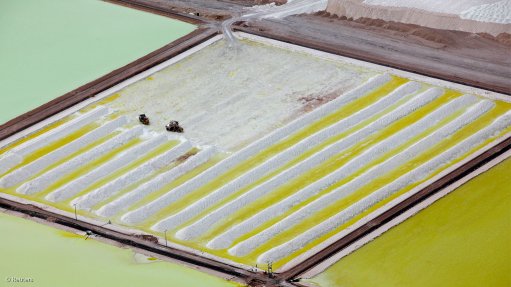
Photo by: Reuters
TORONTO (miningweekly.com) – Mere weeks after forming a 50:50 joint venture (JV) with global chemicals company Sociedad Química y Minera de Chile (SQM) to develop the significant Cauchari-Olaroz lithium project in Jujuy, Argentina, Canadian project developer Lithium Americas (LAC) has signed a nonexclusive memorandum of understanding (MoU) to form a strategic alliance with Spain-based organoclay specialist TOLSA.
Under the MoU announced on Tuesday, which expounded a number of areas of collaboration aimed at pursuing growth opportunities in the global clay minerals markets, LAC (formerly Western Lithium) subsidiary Hectatone would supply hectorite clay from its Nevada resource to TOLSA for the manufacture of high-purity hectorite-based products.
TOLSA had evaluated laboratory samples of hectorite clay, and a bulk sample was scheduled to be trialled in TOLSA’s pilot facility in Spain this month.
Founded more than half a century ago, TOLSA was a privately held specialist in the clay sector, based in Madrid, Spain. The company controlled more than 20 mining operations globally and produced high-quality raw materials such as sepiolite, bentonite and attapulgite.
TOLSA employed more than 850 people operating across four continents and had more than one-million tonnes of operating capacity, with significant geological and product research and development laboratories and global distribution and logistical capacity.
LITHIUM DEVELOPMENT
More significantly, LAC, the parent company of Minera Exar, which was developing the Cauchari-Olaroz lithium project, late last month entered into a JV with SQM.
Under the terms of the deal, SQM bought a 50% stake in Minera Exar for $25-million, including $15-million cash and a promise to fund $10-million of development at the project.
“While below our expectations, LAC gains an increased chance of production, a stalled project is kick-started, and further value may now be unlocked. Argentine economic reform, strong lithium demand, rising LCE [lithium carbonate equivalent] prices, low costs, long-life production potential, large resources, and full permits make LAC an attractive investment,” stated Dundee Capital Markets director of mining research David Talbot in a recent research note.
According to LAC, more than $1-billion had been spent over the past seven years in lithium development projects, which had, to date, resulted in a minimal increase in lithium supplies.
Cauchari-Olaroz was believed to be the world’s third-largest lithium brine resource and was fully permitted for immediate construction and development. The company advised that the project benefited from excellent infrastructure, including a nearby natural gas pipeline, a paved international highway with direct access to Salar de Atacama and a deep-sea port, as well as fresh water on site, and strong support from local communities and the government of Jujuy province.
Since its inception in 2009, LAC had invested more than C$80-million in a resource exploration and project development programme, which included resource definition, advanced modelling, about 10 000 m of drilling, testing and pumping wells and National Instrument (NI) 43-101-compliant technical studies, including a definitive feasibility study (DFS) completed in 2012.
According to the DFS, the operation would be based on a production capacity of 20 000 t/y lithium carbonate and result in a post-tax net present value of $464-million, with average yearly net cash flows of $117-million. This was based on forecast LCE average prices of about $5 900/t, well below current world prices.
The JV was now targeting doubling production capacity to about 40 000 t/y of lithium equivalent in its upcoming development plan investigations to update the DFS.
“SQM appears to want to protect its LCE market share by increasing supply. Both SQM and LAC are responsible for its share of financing, thus, an NI 43-101 update was required. Production by 2018 remains the goal. We expect higher lithium price assumptions, doubled production rate, lower costs, weaker local currency, removal of export duty, elimination of a demo plant, plus any other SQM cost savings,” Talbot added, noting that the original two-year construction and start-up horizon remained intact.
Meanwhile, LAC filled four vacancies during its recent annual general meeting, shoring up technical and financial expertise with the appointment of Nicole Adshead-Bell, Gabriel Rubacha and Lenard Boggio to the board, with lead LAC investor George Ireland becoming chairperson.
With strong new management in place and the new board buying shares, analysts noted that LAC was increasingly attracting institutional investor support.
Dundee had recently revised its rating of LAC to 'buy’ with a target price of C$1.60 a share, from a previous target price of C$1.20 a share.
LAC was also the parent to Lithium Nevada, which owned one of the largest lithium resources in North America.
LAC’s TSX-listed stock had more than doubled since the start of the year to C$0.67 apiece on Tuesday.